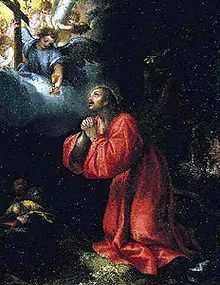Denis Calvaert
| Denis Calvaert | |
|---|---|
 Agony in the Garden of Gethsemani | |
| Birth name | Denys Calvaert, Il Fiamingo |
| Born |
1540 Antwerp |
| Died |
16 April 1619 Bologna |
| Nationality | Flanders |
| Field | Painting |
| Movement | Baroque |
| Wikimedia Commons has media related to Denys Calvaert. |
Denis (or Denys) Calvaert (1540 – 16 April 1619) was a Flemish painter born at Antwerp, who lived in Italy for most of his life, where he was known as Dionisio Fiammingo[1] or simply Il Fiammingo (the Fleming). Calvaert was a profound student of architecture, anatomy, and history, his works are characterized by their advanced composition and colouring.
Biography
After studying landscape-painting for some time in his native city (the Antwerp "Record of Artists" or "Liggeren" (1556–57), gives his name as Caluwaert), he first studied under Christiaen van Queecborn.
He then went to Bologna, where worked under Prospero Fontana. His paintings acquired the mannerism of Flemish art and appeared to be the work of an Italian. From Bologna he went to Rome in 1572, where he assisted Lorenzo Sabbatini in his works for the papal palace of the Vatican.
He returned to Bologna and founded a studio. He had a number of prominent young apprentices, including Guido Reni, Giovanni Battista Bertusio, Francesco Albani and Domenichino, who soon followed Annibale Carracci's example and took prominent commissions in Rome. Vicenzio Gotti and Giacomo Semenza also worked in his studio, before joining the studio of Guido Reni. Calvaert worked with Vincenzo Spisanelli and Gabriello Ferrantini as well.[2]
Calvaert was respected by his fellow citizens in Bologna and by his colleagues, as shown by the presence of Ludovico Carracci, then leader of a competing studio, accompanied by all of his students, at Calvaert's funeral in the Basilica di Santa Maria dei Servi.[citation needed]
Style and legacy
Calvaert typically used chiaroscuro techniques to set stylized foreground figures derived from Correggio against northern European landscapes. His use of colour also reflects the influence of Barocci. While continuing to pursue a mannerist aesthetic throughout his career, Calvaert became a significant contributor the brand of classicism that came to characterize the Bolognese school of painting from the start of the 17th century.[3]
His principal works are to be seen at Bologna, Florence, St. Petersburg, Parma, and Caen, and many of his pictures have been engraved. Many of his works are in the National Art Gallery of Bologna, while "St Michael", one of his most renowned works, is in the Basilica of San Petronio.
References
- ↑ "Calvaert ‹kàlvaart›, Denijs, detto Dionisio Fiammingo". Treccani (in Italian). Retrieved 3 December 2013.
- ↑ Hobbes, James R. (1849). 's Picture collector's manual adapted to the professional man, and the amateur. T&W Boone, 29 Bond Street; Digitized by Googlebooks. p. 33.
- ↑ Van Miegroet, Hans J. "Calvaert, Denys". Oxford Art Online. Oxford University Press. Retrieved 3 December 2013. (subscription required)
- This article incorporates text from a publication now in the public domain: Wood, James, ed. (1907). "article name needed". The Nuttall Encyclopædia. London and New York: Frederick Warne.
 This article incorporates text from a publication now in the public domain: Chisholm, Hugh, ed. (1911). Encyclopædia Britannica (11th ed.). Cambridge University Press
This article incorporates text from a publication now in the public domain: Chisholm, Hugh, ed. (1911). Encyclopædia Britannica (11th ed.). Cambridge University Press This article incorporates text from a publication now in the public domain: Herbermann, Charles, ed. (1913). Catholic Encyclopedia. Robert Appleton Company.
This article incorporates text from a publication now in the public domain: Herbermann, Charles, ed. (1913). Catholic Encyclopedia. Robert Appleton Company.
External links
- Denys Calvaert On-Line. ArtCyclopedia.
|